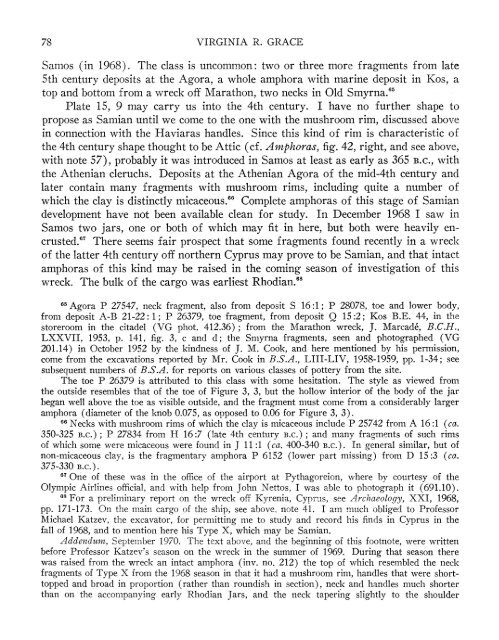SAMIAN AMPHORAS - The American School of Classical Studies at ...
SAMIAN AMPHORAS - The American School of Classical Studies at ...
SAMIAN AMPHORAS - The American School of Classical Studies at ...
Create successful ePaper yourself
Turn your PDF publications into a flip-book with our unique Google optimized e-Paper software.
78 VIRGINIA R. GRACE<br />
Sanlos (in 1968). <strong>The</strong> class is uncommon: two or three more fragments from l<strong>at</strong>e<br />
5th century deposits <strong>at</strong> the Agora, a whole amphora with marine deposit in Kos, a<br />
top and bottom from a wreck <strong>of</strong>f Mar<strong>at</strong>hon, two necks in Old Smyrna.65<br />
Pl<strong>at</strong>e 15, 9 may carry us into the 4th century. I have no further shape to<br />
propose as Samian until we come to the one with the mushroom rim, discussed above<br />
in connection with the Haviaras handles. Since this kind <strong>of</strong> rim is characteristic <strong>of</strong><br />
the 4th century shape thought to be Attic (cf. Amphoras, fig. 42, right, and see above,<br />
with note 57), probably it was introduced in Samos <strong>at</strong> least as early as 365 B.C., with<br />
the Athenian cleruchs. Deposits <strong>at</strong> the Athenian Agora <strong>of</strong> the mid-4th century and<br />
l<strong>at</strong>er contain many fragments with mushroom rims, including quite a number <strong>of</strong><br />
which the clay is distinctly micaceous.6" Complete amphoras <strong>of</strong> this stage <strong>of</strong> Samian<br />
development have not been available clean for study. In December 1968 I saw in<br />
Samos two jars, one or both <strong>of</strong> which may fit in here, but both were heavily en-<br />
crusted.67 <strong>The</strong>re seems fair prospect th<strong>at</strong> some fragments found recently in a wreck<br />
<strong>of</strong> the l<strong>at</strong>ter 4th century <strong>of</strong>f northern Cyprus may prove to be Samian, and th<strong>at</strong> intact<br />
amphoras <strong>of</strong> this kind may be raised in the coming season <strong>of</strong> investig<strong>at</strong>ion <strong>of</strong> this<br />
wreck. <strong>The</strong> bulk <strong>of</strong> the cargo was earliest Rhodian."8<br />
65Agora P 27547, neck fragment, also from deposit S 16:1; P 28078, toe and lower body,<br />
from deposit A-B 21-22: 1; P 26379, toe fragment, from deposit Q 15:2; Kos B.E. 44, in the<br />
storeroom in the citadel (VG phot. 412.36) ; from the Mar<strong>at</strong>hon wreck, J. Marcade, B.C.H.,<br />
LXXVII, 1953, p. 141, fig. 3, c and d; the Smyrna fragments, seen and photographed (VG<br />
201.14) in October 1952 by the kindness <strong>of</strong> J. M. Cook, and here mentioned by his permission,<br />
come from the excav<strong>at</strong>ions reported by Mr. Cook in B.S.A., LIII-LIV, 1958-1959, pp. 1-34; see<br />
subsequent numbers <strong>of</strong> B.S.A. for reports on various classes <strong>of</strong> pottery from the site.<br />
<strong>The</strong> toe P 26379 is <strong>at</strong>tributed to this class with some hesit<strong>at</strong>ion. <strong>The</strong> style as viewed from<br />
the outside resembles th<strong>at</strong> <strong>of</strong> the toe <strong>of</strong> Figure 3, 3, but the hollow interior <strong>of</strong> the body <strong>of</strong> the jar<br />
began well above the toe as visible outside, and the fragment must come from a considerably larger<br />
amphora (diameter <strong>of</strong> the knob 0.075, as opposed to 0.06 for Figure 3, 3).<br />
66 Necks with mushroom rims <strong>of</strong> which the clay is micaceous include P 25742 from A 16 :1 (ca,<br />
350-325 B.C.); P 27834 from H 16:7 (l<strong>at</strong>e 4th century B.C.); and many fragments <strong>of</strong> such rims<br />
<strong>of</strong> which some were micaceous were found in J 11:1 (ca. 400-340 B.C.). In general similar, but <strong>of</strong><br />
non-micaceous clay, is the fragmentary amphora P 6152 (lower part missing) from D 15:3 (ca.<br />
375-330 B.C.).<br />
67 One <strong>of</strong> these was in the <strong>of</strong>fice <strong>of</strong> the airport <strong>at</strong> Pythagoreion, where by courtesy <strong>of</strong> the<br />
Olympic Airlines <strong>of</strong>ficial, and with help from John Nettos, I was able to photograph it (691.10).<br />
68 For a preliminary report on the wreck <strong>of</strong>f Kyrenia, Cyprus, see Arch4aeology, XXI, 1968,<br />
pp. 171-173. On the main cargo <strong>of</strong> the ship, see above, note 41. I am much obliged to Pr<strong>of</strong>essor<br />
Michael K<strong>at</strong>zev, the excav<strong>at</strong>or, for permitting me to study and record his finds in Cyprus in the<br />
fall <strong>of</strong> 1968, and to mention here his Type X, which may be Samian.<br />
Addendum, Sqeptember 1970. rhe text above, and the beginning <strong>of</strong> this footnote, were written<br />
before Pr<strong>of</strong>essor K<strong>at</strong>zev's season on the wreck in the summer <strong>of</strong> 1969. During th<strong>at</strong> season there<br />
was raised from the wreck an intact amphora (inv. no. 212) the top <strong>of</strong> which resembled the neck<br />
fragments <strong>of</strong> Type X from the 1968 season in th<strong>at</strong> it had a mushroom rim, handles th<strong>at</strong> were short-<br />
topped and broad in proportion (r<strong>at</strong>her than roundish in section), neck and handles much shorter<br />
than on the accompanying early Rhodian Jars, and the neck tapering slightly to the shoulder

















